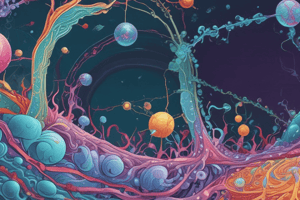Podcast
Questions and Answers
Which of the following best describes the function of the plasma membrane?
Which of the following best describes the function of the plasma membrane?
- To facilitate cell division
- To serve as a selective barrier for transport (correct)
- To generate energy for the cell
- To store genetic information
What is the primary difference between active and passive transport mechanisms across the plasma membrane?
What is the primary difference between active and passive transport mechanisms across the plasma membrane?
- Active transport requires energy, while passive transport does not (correct)
- Active transport does not require energy, while passive transport does
- Both processes require cellular energy to function
- Passive transport occurs against the concentration gradient, while active transport occurs with it
Which structures in the plasma membrane are primarily involved in the transport of substances?
Which structures in the plasma membrane are primarily involved in the transport of substances?
- Phospholipid bilayer
- Cholesterol molecules
- Transport proteins (correct)
- Integral sugars
In terms of cell function, what role does the plasma membrane play?
In terms of cell function, what role does the plasma membrane play?
How much percentage of the overall assessment is contributed by the final-term examination?
How much percentage of the overall assessment is contributed by the final-term examination?
Which type of membrane protein is integrated tightly into the lipid bilayer?
Which type of membrane protein is integrated tightly into the lipid bilayer?
What does passive transport NOT require?
What does passive transport NOT require?
Which of the following describes a hypotonic solution?
Which of the following describes a hypotonic solution?
Which process involves the movement of large substances into the cell?
Which process involves the movement of large substances into the cell?
What is the primary function of receptor proteins in the membrane?
What is the primary function of receptor proteins in the membrane?
Active transport involves moving substances:
Active transport involves moving substances:
In a hypertonic solution, the concentration of dissolved substances is:
In a hypertonic solution, the concentration of dissolved substances is:
What role do adhesion molecules play in a cell?
What role do adhesion molecules play in a cell?
What is a primary function of the plasma membrane?
What is a primary function of the plasma membrane?
What property do phospholipids exhibit that contributes to the formation of the lipid bilayer?
What property do phospholipids exhibit that contributes to the formation of the lipid bilayer?
Which of the following statements about integral proteins is true?
Which of the following statements about integral proteins is true?
How does cholesterol affect the fluidity of the plasma membrane?
How does cholesterol affect the fluidity of the plasma membrane?
What is meant by the term 'selective permeability' in regard to the plasma membrane?
What is meant by the term 'selective permeability' in regard to the plasma membrane?
Which component of the plasma membrane is primarily responsible for cell-cell recognition?
Which component of the plasma membrane is primarily responsible for cell-cell recognition?
What aspect of the plasma membrane is described by the 'fluid mosaic model'?
What aspect of the plasma membrane is described by the 'fluid mosaic model'?
What role do glycolipids play in the plasma membrane?
What role do glycolipids play in the plasma membrane?
Study Notes
Introduction to Membrane Biochemistry
- Plasma membrane is the outer layer of a cell, serving as a "gatekeeper" and controlling the passage of substances in and out.
Plasma Membrane Functions
- Separates internal organelles from the external environment.
- Regulates the entrance and exit of substances.
- Transfers information between cells.
- Establishes an electric potential difference.
- Serves as a site for biological activities.
- Facilitates attachment between cells.
- Removes waste products.
Plasma Membrane Structure
- Lipids:
- Phospholipids, glycolipids, and steroids are the main components.
- Their hydrophilic and hydrophobic properties contribute to membrane flexibility.
- Proteins:
- Integral proteins form transport channels.
- Peripheral proteins act as recognition sites.
- Both determine the specific functions of the membrane.
- Carbohydrates: Play a role in cell-cell recognition.
Lipid Bilayer Model
-
Cross Section:
- Two sheets of lipids, ~7.5 nm thick, form the bilayer.
- Found around the cell.
- Embedded with proteins.
- Strengthened by cholesterol molecules (in animal cells).
-
Phospholipid: Has a hydrophilic head and a hydrophobic tail.
- The head is water-loving and faces the inner and outer cell environments.
- The tail is water-fearing and resides within the central section of the bilayer.
Membrane Lipids
- Phospholipids:
- Most abundant lipids in cell membranes.
- Arranged in a lipid bilayer.
- The bilayer is fluid due to its structure (Fluid Mosaic Model).
- Cholesterol:
- Dissolved in the lipid bilayer.
- Regulates the fluidity of the membrane.
- At moderate concentrations, it decreases fluidity.
- At higher concentrations, it increases fluidity.
- Permeability:
- The lipid bilayer is permeable to lipids and lipid-soluble substances.
- Water and water-soluble substances cannot pass through the bilayer.
- Large molecules cannot penetrate the bilayer.
Membrane Proteins
- Mostly exist as glycoproteins.
- Types:
- Integral membrane proteins: Tightly integrated into the lipid bilayer.
- Peripheral membrane proteins: Loosely attached to lipids or integral membrane proteins.
- Functions:
- Transport proteins: Facilitate the passage of water and water-soluble substances.
- Receptors: Receive signals for cell-to-cell communication.
- Second messengers: Participate in intracellular signaling.
- Enzymes: Act as catalysts.
- Adhesion molecules: Connect cells to the extracellular matrix or to other cells.
- Submembrane cytoskeleton: Provides strength and resistance to the membrane.
- Antigens: Participate in immune reactions.
Passive Transport
-
Simple Diffusion:
- No energy required.
- Based on diffusion and osmosis.
- Movement of small molecules from high concentration to low concentration.
- Examples: O2, CO2, and H2O.
-
Facilitated Diffusion:
- Proteins act as channels or tunnels, facilitating the passage of larger polar molecules.
- Carrier proteins aid in transporting substances across the membrane.
- Examples: glucose.
- Movement along the concentration gradient.
Active Transport
-
Requires energy to move molecules against the concentration gradient (from low to high concentration).
-
Sodium-potassium pump is an example.
-
Vesicular Transport:
- Movement of large substances using vesicles.
- Endocytosis: Taking substances into the cell.
- Phagocytosis: Engulfing solid particles.
- Pinocytosis: Engulfing liquid substances.
- Receptor-mediated endocytosis: Specific binding of substances to receptors on the membrane surface.
- Exocytosis: Expelling substances from the cell (originating from the ER or Golgi apparatus).
Types of Solutions
- Isotonic: Equal concentration of dissolved substances inside and outside the cell.
- Hypotonic: Lower concentration of dissolved substances outside the cell compared to inside.
- Hypertonic: Higher concentration of dissolved substances outside the cell compared to inside.
Homeostasis
- The plasma membrane maintains a constant internal environment.
- It controls the movement of materials in and out of the cell, serving as a "gatekeeper."
- It establishes a dynamic equilibrium.
- It separates cellular organelles from the external environment.
Vocabulary Review
- Plasma membrane
- Homeostasis
- Passive transport
- Simple diffusion
- Facilitated diffusion
- Active transport
- Hydrophilic
- Hydrophobic
- Endocytosis
- Exocytosis
- Isotonic
- Hypertonic
- Hypotonic
Studying That Suits You
Use AI to generate personalized quizzes and flashcards to suit your learning preferences.
Related Documents
Description
Explore the key concepts of membrane biochemistry, focusing on the structure and functions of the plasma membrane. This quiz will cover the roles of lipids, proteins, and carbohydrates, as well as the lipid bilayer model. Test your understanding of how these components contribute to cellular processes.




